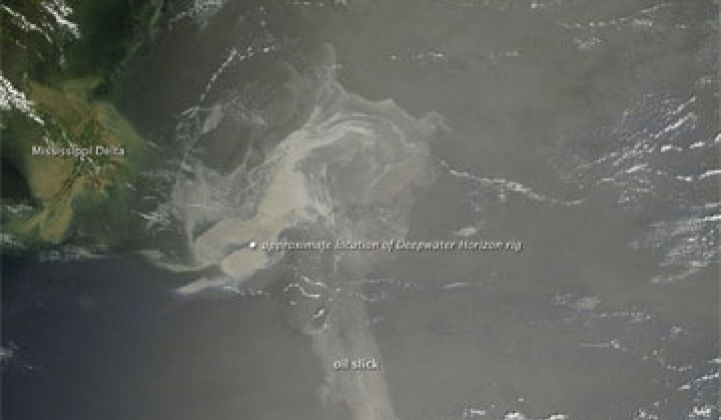Calls for "drill, baby, drill" have been muted recently. Americans of all political persuasions are outraged by the BP Deepwater Horizon gusher (it's not a spill that can just be stopped and wiped up) in the Gulf of Mexico. This as-yet-uncontained catastrophe highlights the significant risks inherent in deep-water, offshore drilling near our coastlines. The tragic loss of human life, as well as the environmental and economic impacts, are enormous. Irreparable damage has been caused to the Gulf of Mexico tourist industry, which is estimated by the Environmental Protection Agency at $20 billion, and to Gulf Coast commercial and recreational fishing, with the direct cost already estimated at over $6 billion. The lasting impact and actual cost likely will not be known for years to come. Following the Exxon Valdez disaster in 1989 and this recent tragedy, we cannot, and need not, take this risk anymore.
Everyone agrees that reducing oil imports enhances our national security. To do so, we can produce more domestic oil from onshore sources and at the same time capture and store our carbon dioxide (CO2) in the oil reservoirs, greatly reducing emissions of this global-warming pollutant. America has ample supplies of oil onshore, but these stranded reserves are trapped in pockets that need to be pressurized to lift the oil economically -- a process called "enhanced oil recovery," or EOR. EOR enables the production of "stranded" oil by injecting CO2 to restore the pressure. The CO2 gets sequestered in the reservoir under the cap rock and is measured and monitored to ensure there is no leakage.
There are currently 105 existing EOR projects producing over 240,000 barrels per day, and ironically, the supply of CO2 is from naturally occurring drilled sources rather than man-made emissions. Oil producers currently pay for this CO2, and they will pay for CO2 captured from power plants and industrial facilities, as well. EOR production could be increased dramatically if CO2 were made available through capture from existing coal-fired power plants and industrial facilities.
EOR has other important advantages. Unlike offshore exploration and development, onshore CO2 EOR production is far safer, much less expensive, and faster to develop. Operators of these fields have decades of experience with the geologic formations, so there is no exploration risk, and producers have already identified the most attractive candidates for CO2 EOR. The U.S. Department of Energy estimates availability of 90 billion barrels of recoverable oil that could be produced using CO2 EOR, enough to completely eliminate oil imports for the next 23 years or shut in all domestic offshore production for 180 years. Moreover, if we produced all 90 billion barrels using CO2 EOR over the next 20 years, we could sequester 3 billion tons of CO2 annually, which is more than the overall emissions from every coal-fired power plant in the country. The availability and production capacity of onshore CO2 EOR dwarfs the potential reserves and production from offshore drilling by a factor of 10, with no exploration, production and, of course, spill risks.
Environmental advocacy group Natural Resources Defense Council, in partnership with Advanced Resources International, a CO2-EOR advisory firm, estimates that 1.3 million barrels per day (mb/d) of new oil production in 2020 from CO2 EOR rising to almost 5 mb/d in 2050. EOR production, combined with efforts to increase biofuels usage, introduce improved vehicle fuel efficiency, and encourage the adoption of electric vehicles, would allow America to cut oil imports in half and dramatically strengthen our national security. At today's prices, that could mean a cumulative savings through 2050 of more than $2 trillion. The tax revenues at the state and federal levels resulting from more domestic production would be extraordinary. In addition, the impact on the global oil market would lead to lower prices and reductions in volatility.
Unfortunately, the growth of the EOR market has been constrained by the availability of CO2. The challenge is capturing all that CO2 from power plants and industrial facilities and delivering it to EOR sites. Large-scale demonstration projects using gasification to capture CO2 before combustion as well as from stack gases after combustion are underway. However, these options are still costly -- the Dept. of Energy estimates costs of over $50/ton just to capture the CO2 after combustion. Transportation and injection add to the cost. With a typical ratio of 1-2 barrels of oil produced for every ton of CO2 injected, an additional incentive is needed beyond the price oil companies can economically afford to pay for CO2 purchases, and this incentive must be derived from the regulation of carbon emissions.
A price and a cap on carbon in legislation such as the American Power Act proposed by Senators Kerry and Lieberman will ensure abundant supplies of CO2 to stimulate an extraordinary renewal in onshore oil production, avoid offshore oil spills, and allow us to sequester carbon for hundreds of years. Moreover, we will create jobs, promote economic development and enhance our energy security. Over time, we can fully expect American ingenuity to reduce the cost of carbon capture and enable the technology to be deployed at scale, and oil companies will be attracted to long-term secure supplies. On this basis, we can develop transportation infrastructure similar to that which was developed fifty years ago for the natural gas industry. But, the energy markets will not respond unless there is a transparent, predictable and long-term price on carbon as set forth in the American Power Act. President Obama supports the continuity of a domestic oil industry and has been an outspoken proponent of legislation addressing climate change and energy efficiency. Carbon capture and sequestration for enhanced oil recovery is the magic bullet that meets both of these goals and perhaps more importantly, eliminates the need for offshore drilling.
(See "How To Make Money in Carbon Capture.")
***
Daniel Goldman, an energy industry executive, is currently the EVP & CFO of GreatPoint Energy, a partner at Clean Energy Venture Group, and a co-founder of Environmental Entrepreneurs.



